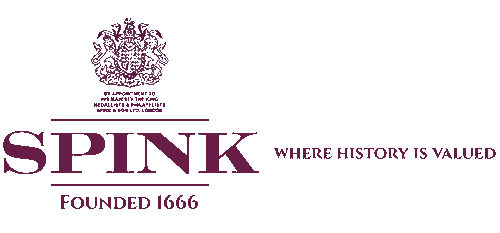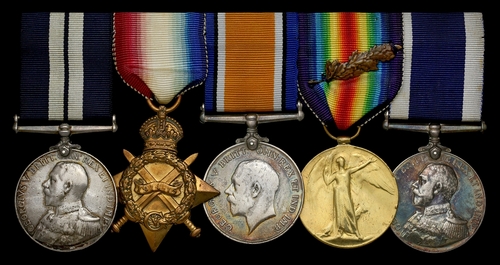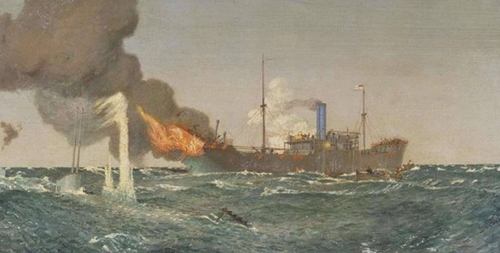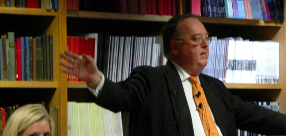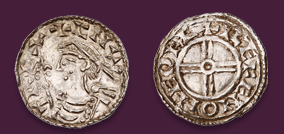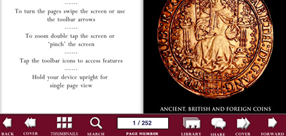Auction: 25003 - Orders, Decorations and Medals
Lot: 178
The superb 'V.C. Winning, Q-Ship action' D.S.M. group of five awarded to Leading Seaman T. S. Cunningham Royal Navy, who served with Stock Force when her skipper, Lieutenant Harold Auten, won his Victoria Cross
One of the ship's two gunners, Cunningham's was the difficult task of remaining in position, unseen, letting their prey inch closer, even as the vessel slowly sank around him
Distinguished Service Medal, G.V.R. (J.7483. T R Cunningham, Ldg. Sea., English Channel, 30th July 1918.); 1914-15 Star (J.7483. T. R. Cunningham A.B.. R.N.); British War and Victory Medals (J.7483. T. R. Cunningham. L.S. R.N.), with M.I.D. oakleaves; Royal Navy L.S. & G.C., G.V.R. (J.7483. T. R. Cunningham. L.S. H.M.S. Hood.), mounted as worn, edge bruise, polished, contact marks, nearly very fine (5)
D.S.M. London Gazette 14 September 1918, the original recommendation states:
'This rating also brought his gun into action very quickly and he scored twelve hits out of the fourteen rounds fired.'
M.I.D. London Gazette 2 November 1917.
Thomas Robinson Cunningham was born at Castlereagh, County Down on 23 February 1894 and enlisted on 12 February 1910 with the rank of Boy Class II. Appointed Ordinary Seaman on 23 February 1912 with Vanguard he was advanced Able Seaman on 16 December 1912 with Majestic.
Serving ashore when the Great War began Cunningham was posted to Warrior on 18 July 1915, he was still with her she steamed out for service in the Battle of Jutland. Warrior served with the 1st Cruiser Squadron under Rear-Admiral Arbuthnot and was the only ship from the Squadron to follow his flagship the Defence during their 'mad charge' into the heart of the German Fleet. Defence was totally destroyed by heavy German fire while Warrior remained afloat, however she had taken fifteen shells and was seriously damaged, indeed she was only saved when the enemy switched their fire to Warspite.
Shortly afterwards in June 1916 Cunningham transferred ashore where he remained until October before joining his first Q-Ship HMS Heather, Q16. This vessel was officered by Lieutenant-Commander Hallwright and officered by Lieutenant Harold Auten, who was later to earn his laurels in command of Stock Force.
Auten was to take command of Heather during an abortive engagement on 21 April 1917 when Hallwright was killed by a German shell. Remaining in command Auten was awarded the D.S.C. on 2 August 1917 for his success in the English Channel. Cunningham also earned laurels on with Heather, gaining a 'mention' for an action under Auten's command (London Gazette 2 November 1917).
A collision between Heather and a sailing vessel saw Auten posted to a new command, Stock Force, with him went Cunningham who transferred that day to same vessel. It may be that he was a hand-picked man as Auten clearly trusted him to fire one of the ship's two four-inch guns, an extremely important role for an ambush predator like the Q-ship.
Stock Force's greatest and final action came at 5pm on 30 July 1918 when UB80 torpedoed her forward of the main bulkhead. Auten was blown under the chart table and at least one officer was trapped beneath wreckage, remaining there until the action was over whilst the ship slowly sank. The rest of the crew stood to with their 'panic party' deploying and the rest taking up their positions, Auten's combat report outlines the unenviable position in which they found themselves:
'Although many were suffering with wounds and all from the tremendous shock sustained through a torpedo striking so small a ship and the apparent imminence of her foundering, everyone went about their duties which included lying doggo for a full 40 minutes on the part of the Gun's Crews and later stoking in a stokehold fast filling with water, as though there were exercising at quarters. The success of this action was due to their splendid behaviour.'
Cunningham was amongst the former group, waiting steadily by his gun and doubtless listening to the ship's dying agonies as he did so. Q-Ship's and their Story by Keeble-Chatterton outlines the action as it unfolded:
'In accordance with the training, the 'panic' party then began to row down the port side towards the port quarter so as to draw the enemy on, and this manoeuvre succeeded in fooling the German, who now came down the port side as required, being only about three hundred yards away. As soon as the enemy was full on the beam of Stockforce, the latter handed him the surprise packet. It was now 5.40 p.m. as both 4-inch guns opened fire from the Q-ship. The first round from the after gun passed over the conning-tower, carrying away the wireless and one of the periscopes, the second shell hitting the conning-tower in the centre and blowing it away, sending high into the air a man who was in the conning-tower.
Stockforce's second 4-inch gun hit the enemy with her first shot on the water-line at the base where the conning-tower had been, tearing the submarine right open and blowing out many of the crew. A large volume of blue smoke began to pour out of the U-boat, and shell after shell was then poured into the German until she sank by the stern, by which time twenty direct hits had been obtained. The enemy submerged, leaving a quantity of debris on the water, and was never seen again. But in the meantime, Stockforce was in a critical condition, and every attempt now was made to save her from foundering. Having recalled the 'panic' party, the engines were put full speed ahead in the effort to reach the nearest land and beach her, as she was rapidly listing to starboard and going down by the head. At 6.30 p.m. two trawlers were sighted who closed the ship, and as Stockforce was already practically awash forward and along most of the starboard side, all the wounded and half the men were now transferred to one of these trawlers.'
Behind one of the two four-inch guns was Cunningham who, as his recommendation makes clear, was not at all dissuaded by the dire nature of their situation landing twelve of fourteen shells, a terrific accurate barrage. He was awarded his D.S.M. as a result of the action and went on to serve with H.M.S. Suffolk Coast, again with Auten, ending his tenure with her on 11 February 1919.
He continued to serve for a number of years becoming a Pensioner Instructor on 22 November 1934. The 1939 census places him in Plymouth with his wife, working as an 'Instructor RN Barracks Petty Officer'. He does not appear entitled to any awards of the Second World War, and died at City Hospital, Plymouth on 21 December 1959; sold together with an extensive archive of copied research.
Subject to 20% VAT on Buyer’s Premium. For more information please view Terms and Conditions for Buyers.
Estimate
£1,400 to £1,800
Starting price
£1100
